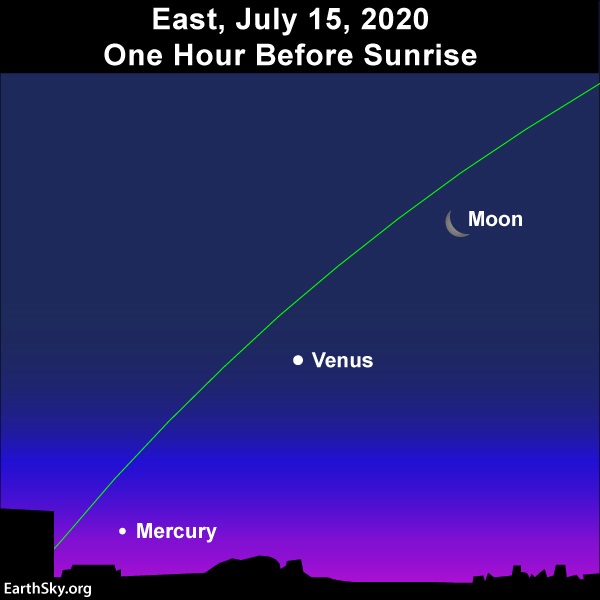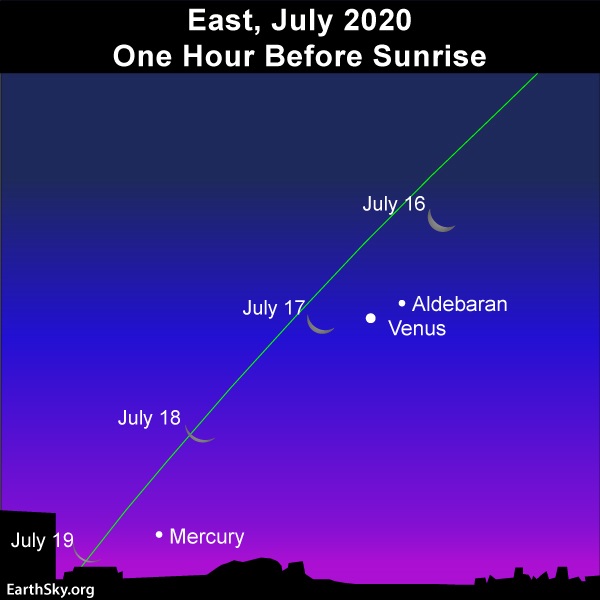

Use the waning crescent moon and the brilliant planet Venus to locate Mercury near the horizon.
Mercury – the solar system’s innermost planet – is often hard to spot in Earth’s sky. That’s because this world never strays far from the sun’s glare. At times when Mercury is visible, it’s out for only a short period after sunset or before sunrise. Although Mercury can be bright, its luster is frequently tarnished by the glow of evening dusk or morning dawn. These next several weeks, though, present your opportunity to spot Mercury before sunrise, as the morning darkness is giving way to dawn.
Mercury is only moderately-bright in mid-July 2020, but is brightening day by day. By early August 2020, Mercury will be some 10 times brighter. In mid-July, we are fortunate because we can use the two brightest celestial bodies of nighttime, the moon and the dazzling planet Venus, to help us find Mercury. On July 15 and 16, draw an imaginary line from the moon and past Venus to locate Mercury’s spot near the horizon. If you can’t see Mercury with the unaided eye, try binoculars!

In mid-July 2020, the lit side of the waning crescent moon points to Mercury, the innermost planet. After the moon drops out of the morning sky (around July 20), then use Venus as your guide. Read more.
Although the moon will drop out of the morning sky by around July 19 or 20, 2020, Venus will remain in the morning sky all through Mercury’s morning apparition (which comes to an end on August 17, 2020). Look for Mercury beneath Venus, and rather close to the sunrise point on the horizon, an hour or more before sunup.
At mid-northern latitudes, Mercury will fall too close to the sunrise to be visible after the first week of August 2020. At temperate latitudes in the Southern Hemisphere, Mercury will fade from view in late July/early August.
Mercury reaches its greatest elongation on July 22, 2020, at which juncture Mercury will be 20 degrees west of the sun. After that date, Mercury will slowly fall sunward day by day.
Here are Mercury’s approximate rising times for 40 degrees north latitude, the equator (0 degrees latitude) and 35 degrees south latitude (given an unobstructed eastern horizon):
40 degrees north latitude:
July 15: Mercury rises 66 minutes (1 1/10 hours) before the sun
July 22: Mercury rises 90 minutes (1 1/2 hours) before the sun
August 1: Mercury rises 80 minutes (1 1/3 hours) before the sunEquator (0 degrees latitude)
July 15: Mercury rises 75 minutes (1 1/4 hours) before sunrise
July 22: Mercury rises 84 minutes (1 2/5 hours) before sunrise
August 1: Mercury rises 66 minutes (1 1/10 hours) before sunrise35 degrees south latitude
July 15: Mercury rises 80 minutes (1 1/3 hours) before sunrise
July 22: Mercury rises 80 minutes (1 1/3 hours) before sunrise
August 1: Mercury rises 45 minutes (3/4 hour) before sunriseFor more specific information, check out recommended sky almanacs
Mercury is only modestly-bright in mid-July 2020, but the waning crescent moon and the planet Venus help you to locate Mercury from about July 15 to 19, 2020. If you can’t see this world with the eye alone, try binoculars!
from EarthSky https://ift.tt/2ZrQ8VF


Use the waning crescent moon and the brilliant planet Venus to locate Mercury near the horizon.
Mercury – the solar system’s innermost planet – is often hard to spot in Earth’s sky. That’s because this world never strays far from the sun’s glare. At times when Mercury is visible, it’s out for only a short period after sunset or before sunrise. Although Mercury can be bright, its luster is frequently tarnished by the glow of evening dusk or morning dawn. These next several weeks, though, present your opportunity to spot Mercury before sunrise, as the morning darkness is giving way to dawn.
Mercury is only moderately-bright in mid-July 2020, but is brightening day by day. By early August 2020, Mercury will be some 10 times brighter. In mid-July, we are fortunate because we can use the two brightest celestial bodies of nighttime, the moon and the dazzling planet Venus, to help us find Mercury. On July 15 and 16, draw an imaginary line from the moon and past Venus to locate Mercury’s spot near the horizon. If you can’t see Mercury with the unaided eye, try binoculars!

In mid-July 2020, the lit side of the waning crescent moon points to Mercury, the innermost planet. After the moon drops out of the morning sky (around July 20), then use Venus as your guide. Read more.
Although the moon will drop out of the morning sky by around July 19 or 20, 2020, Venus will remain in the morning sky all through Mercury’s morning apparition (which comes to an end on August 17, 2020). Look for Mercury beneath Venus, and rather close to the sunrise point on the horizon, an hour or more before sunup.
At mid-northern latitudes, Mercury will fall too close to the sunrise to be visible after the first week of August 2020. At temperate latitudes in the Southern Hemisphere, Mercury will fade from view in late July/early August.
Mercury reaches its greatest elongation on July 22, 2020, at which juncture Mercury will be 20 degrees west of the sun. After that date, Mercury will slowly fall sunward day by day.
Here are Mercury’s approximate rising times for 40 degrees north latitude, the equator (0 degrees latitude) and 35 degrees south latitude (given an unobstructed eastern horizon):
40 degrees north latitude:
July 15: Mercury rises 66 minutes (1 1/10 hours) before the sun
July 22: Mercury rises 90 minutes (1 1/2 hours) before the sun
August 1: Mercury rises 80 minutes (1 1/3 hours) before the sunEquator (0 degrees latitude)
July 15: Mercury rises 75 minutes (1 1/4 hours) before sunrise
July 22: Mercury rises 84 minutes (1 2/5 hours) before sunrise
August 1: Mercury rises 66 minutes (1 1/10 hours) before sunrise35 degrees south latitude
July 15: Mercury rises 80 minutes (1 1/3 hours) before sunrise
July 22: Mercury rises 80 minutes (1 1/3 hours) before sunrise
August 1: Mercury rises 45 minutes (3/4 hour) before sunriseFor more specific information, check out recommended sky almanacs
Mercury is only modestly-bright in mid-July 2020, but the waning crescent moon and the planet Venus help you to locate Mercury from about July 15 to 19, 2020. If you can’t see this world with the eye alone, try binoculars!
from EarthSky https://ift.tt/2ZrQ8VF

Aucun commentaire:
Enregistrer un commentaire